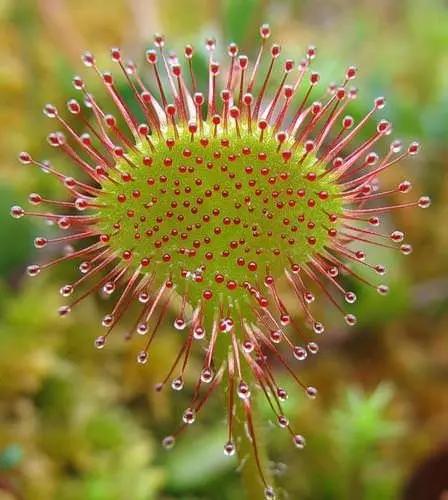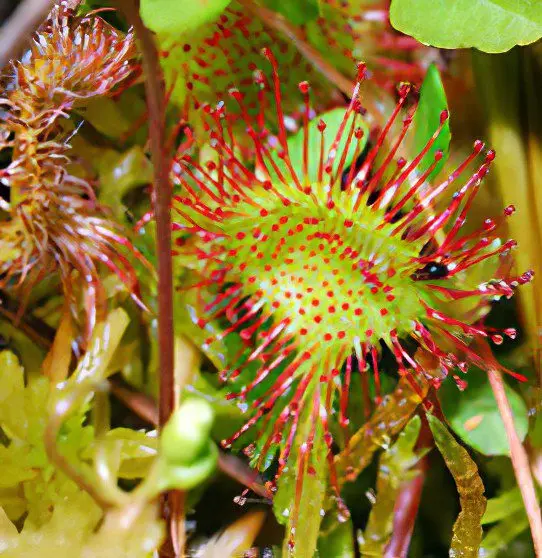Contents
Reproduction, useful properties and recipes for the use of sundew
Botanical characteristics of sundew

Rosyanka rotundifolia is a perennial insectivorous plant from the sundew family. The plant has a short stem, consisting of 2-3 flower arrows and a rosette of leaves, which is pressed to the ground. On the upper side of the leaves are reddish glands with viscous mucus. Small insects that sit on the leaf of the plant are enveloped in this mucus, and the insect eats the flower. The flower of the plant is small, white. Sundew flowers are collected in brushes with one side. Flowering of the plant begins in early summer and lasts until the end of summer.
In the place where the flowers were, the fruits of the plant appear (August-September). The fruits open into 3 leaves. Each fruit contains small spindle-shaped seeds. Sundew can reproduce by self-sowing. They can crumble into sphagnum and immediately be inside the soil, and will germinate after a year.
Sundew prefers to grow in peat and sphagnum bogs, on wet sands. Sundew can be seen in Asia, North America, Ukraine, Russia and the Far East.
Sundew propagation
Sundew propagates by leafy cuttings, which take root with ease and speed. Sundew also reproduces by seed. Seeds are sown on a moist substrate, leaving them not covered with soil. In order to prevent the seeds from being blown away by the wind, they can be covered with glass. For good germination, the seeds need to be constantly moistened. When the seeds sprout, the glass is slightly raised with sticks. Over time, the glass will need to be removed altogether. With the growth of seedlings, they dive. Already dived seedlings are transplanted into separate pots.
Rosyanka can be propagated by dividing the root. To do this, take a clean blade and a container with a lid. We cut off a part of the root from the plant, which can be divided into a couple more parts. The cut site must be treated with activated charcoal. Part of the root must be placed in a container with soil and closed with a lid. After 15 days, a shoot will appear on the spine, which can already be planted in a permanent place in the ground.
Sundew should always be in moist soil, do not allow the soil to dry out. For irrigation, only soft water is needed. Rosyanka loves sunny places. Sundews need to be repotted every spring.
Useful properties of sundew
Sundew leaves contain ascorbic acid, tannins, calcium, potassium and fluoroquinols. Sundew has an expectorant property, so it is used for coughs and colds. Sundew is also used to prepare drugs that have diuretic, bactericidal and antipyretic properties.
Sundew preparations help in the treatment of respiratory diseases, such as, for example, whooping cough, bronchitis, laryngitis or tracheitis. Sundew tincture is used for many diseases and ailments.
Sundew is used in the treatment of various diseases of the gastrointestinal tract. Sundew helps reduce asthma attacks.
The use of sundew

Sundew has been used in folk medicine since the Middle Ages. Traditional medicine uses sundew widely and quite successfully. Sundew is used for bronchitis, colds, tuberculosis and atherosclerosis. Rosyanka can treat epilepsy, headaches, candidiasis.
Tincture of evening primrose. We take 10 grams of dry sundew grass and fill them with half a glass of 40% alcohol. Leave for 10 days at room temperature. The finished tincture is filtered and taken in the following dosages:
– children 10 drops;
– adults 15 drops.
Children take no more than 4 times a day, and adults can drink tincture 5 times. Before use, the tincture must be dissolved in 50 grams of water.
Rosyanka infusion. To prepare the infusion, you need to take a teaspoon of dry sundew grass, grind it. Pour 200 ml of boiling water over the grass. Leave the infusion to infuse for 1 hour. After squeezing the infusion and straining, take a tablespoon three times a day. Preferably taken after meals. This infusion can also treat fever.
Infusion of sundew roots in bronchial asthma. We take 1 teaspoon of a mixture of sundew from the roots and sundew grass. Pour a glass of boiling water and leave for 1 hour to infuse. After straining the infusion, take it three times a day before meals in a tablespoon.
Rosyanka tea. To prepare it, you need to take 1 teaspoon of sundew grass and pour it with a glass of boiling water. We leave for 10 minutes. We filter the tea and take 2 cups a day in small sips.
Rosyanki contraindications
Rosyanka should be used in the correct dosages, since if you take a large dose, this will lead to an aggravation of the patient’s condition. If sundew leaves are chewed, then the oral mucosa will be irritated, which will cause vomiting and diarrhea.









